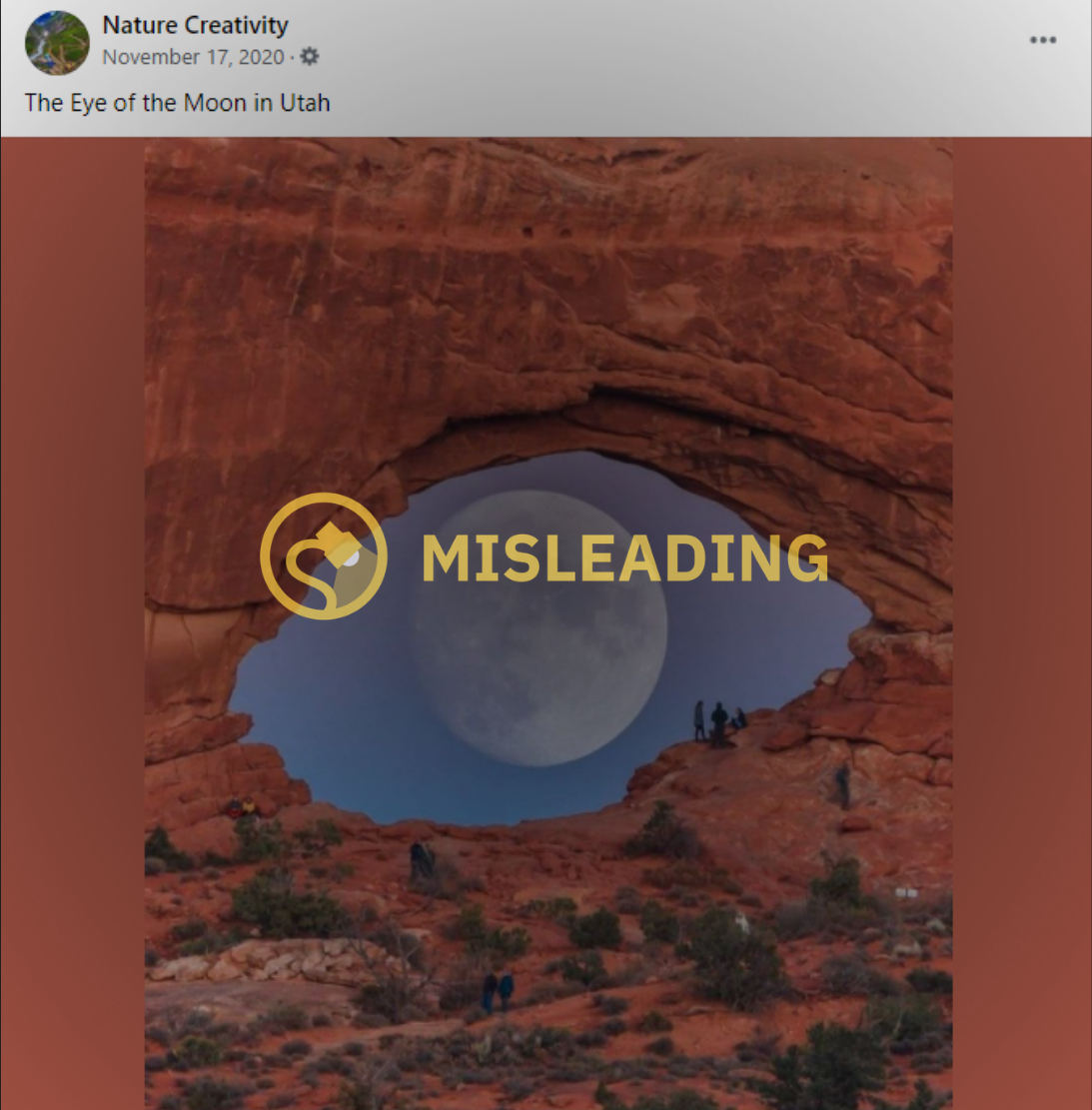An image supposedly showing a large moon sitting perfectly in the middle of a stone arch formation is frequently circulated on social media under the title “The Eye of the Moon in Utah.”
This isn’t a genuine photograph, in the sense that this scene was not visible with the naked eye. However, this isn’t a digitally altered image, either. The original picture was taken by photographer Zach Cooley by using an in-camera double exposure technique. In short, Cooley snapped a photograph, then snapped a second photograph, and layered the images on top of one another. (By labeling it “Misleading,” we don’t mean to accuse Cooley of misrepresentation. Rather, it’s to point out that in many cases the image has been shared on social media with no explanation of how it was constructed.)
Masterclass explains:
Double exposure photography is a technique that layers two different exposures on a single image, combining two photographs into one. Double exposure creates a surreal feeling for your photos and the two photographs can work together to convey deep meaning or symbolism. A similar technique, called a “multiple exposure,” is when you combine more than two exposures in a single image
Cooley provided some of the technical details behind this image in their Instagram post. They wrote that they traveled to Utah in October as the moon was aligning with this arch, that they used an in-camera double exposure to create this image, and that the two images used were taken about a minute apart. Compared to what was seen with the naked eye, the moon is enlarged and centered.
Here’s the original Instagram post:
Cooley writes:
Happy Halloween weekend! I planned an entire vacation mostly around the fact that the moonrise would align with this arch and I could get something resembling a spooky eye on the week of Halloween. Over two nights I got some single shots and double exposures, I thought this one was best for the eye look, what do you think? Can’t wait to share more with you all!
In-camera double exposure
Moon:550mm
F/9
1/160sec.
ISO 160
Arch:250mm
F/9
1/5 sec.
ISO 160
Notes: Photos taken about a minute apart and moon was enlarged and repositioned in the process.
While the “Eye of the Moon in Utah” photograph gives a slightly distorted view of what you would see if you were standing next to the photographer, it isn’t that far off from reality. Here’s a single-exposure photograph from Cooley that shows a very similar scene:
Cooley elaborated on this in-camera double exposure technique in another Instagram post that showed a large moon over Phoenix, Arizona, writing:
Double exposure effects are often achieved in Photoshop or a similar program by importing and manipulating 2 different photos. However, many digital cameras today allow you to merge multiple photos at the time you take them, but of course with none of the flexibility you get with editing software. For this image for example, I captured the city in one shot, then zoomed in and positioned the moon where I wanted it to overlay, and when I snapped that second photo the camera merged it with the first since it was in double exposure mode. Zooming in for the moon photo makes it appear larger in comparison to the city than it did in real life (4X larger in this case). This all may sound easy, but a lot of things have to be just right for this to work out.
I’ve mentioned this before, but to be clear, I have zero issues with Photoshop – it’s a pretty cool tool that opens doors to infinite creativity, among other things. I’m personally just in a place where I have yet to learn how to do things like this in Photoshop, and I’m enjoying trying different things with my camera. I’ve been hesitant to post this, probably most of all because I take pride in a lot of single exposure moon photos I’ve taken, and I fear mixing in images like this could lead people to believe those single exposures are more of the same. Like I’ve said though, I will always specify in the caption. At the end of the day, I’m proud of this image too and happy to share creative work without walls, even if it’s not purist photography. I’m definitely wanting feedback on all this, from photographers and not photographers alike, so please let me know what you think! And thanks for reading my book.
Here’s the moon over Phoenix image:


0 Comments